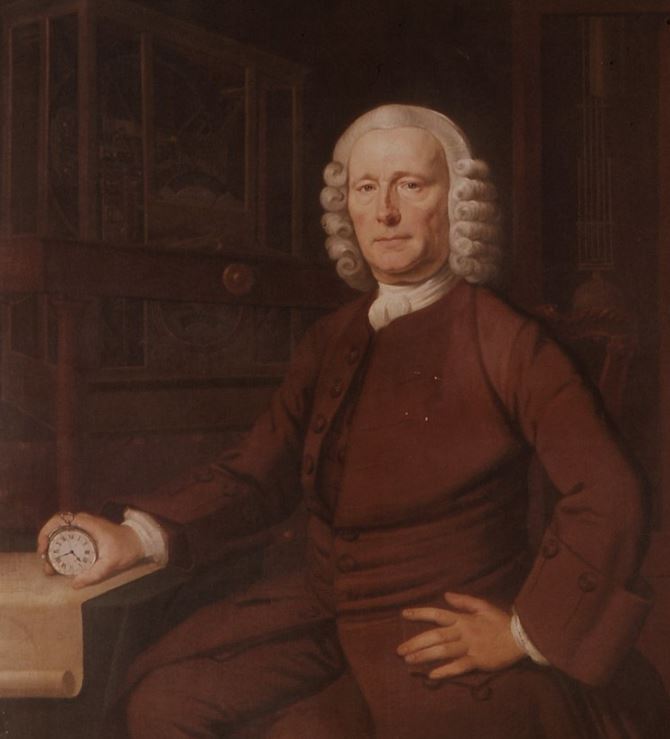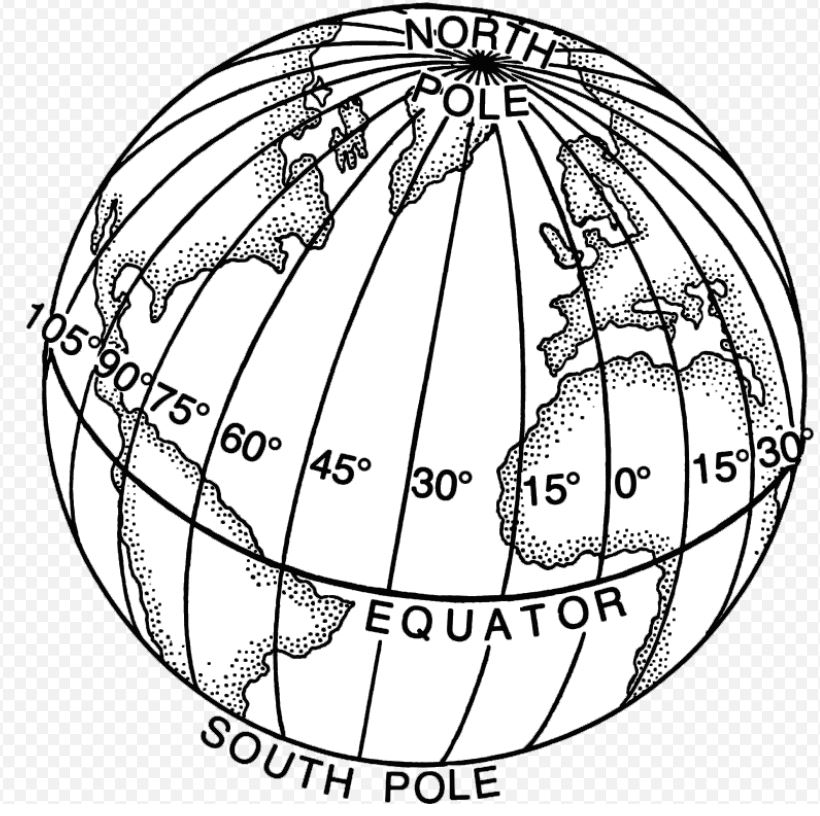John Harrison (1693 – 1776) was an English horologist who invented the first practical marine chronometer, which enabled navigators to accurately determine their longitude at sea. Latitude at sea could easily be calculated by the relative position of the sun and certain stars in the sky at specific times of the day. However, longitude was nearly impossible to tell with any degree of accuracy. It was determined that longitude could be calculated by comparing the local time to the known time at a reference place, such as Greenwich. To do this a reliable clock that could keep the time of the reference place was needed. This was to become Harrison’s lifework.
Early life
John Harrison was born in Foulby, a village in West Yorkshire. He was the first of five children in his family. His stepfather worked as a carpenter on a nearby estate. There is a blue plaque on the house where Harrison was born beside the main Wakefield to Doncaster road. Around 1700, the Harrison family moved to the Lincolnshire village of Barrow upon Humber. Harrison followed his father into the carpentry trade, but also built and repaired clocks in his spare time. According to local parish records, Harrison was married twice. On 30 August 1718, John Harrison married Elizabeth Barret at Barrow-upon-Humber church. After Elizabeth’s death in 1726, he married Elizabeth Scott on 23 November 1726, at the same church.
The longitude problem
Latitude and longitude are coordinates that together, help pinpoint the location of any place on Earth. Both latitude and longitude are angles that uniquely define points on the Earth’s sphere. They constitute a coordinate system or scheme to locate or identify geographic positions anywhere on the Earth’s surface. Latitude is represented by horizontal lines that measure distance north or south of the equator. Longitude is represented by vertical lines that measure east or west of the meridian in Greenwich, England. Together, latitude and longitude enable seafarers to identify their precise location when at sea.
By the 1700s, latitude could be determined by measuring the altitude of the Sun at noon or the altitude of any tabulated star when it crossed the local meridian. However, the determination of longitude at sea remained a serious problem. Without knowing both latitude and longitude, ships were forced to use a process of dead reckoning to know their exact position at sea. Because longitude was only an estimate, at best, thousands of lives were lost when ships ran aground.
Longitude Act
It was known that it was possible to determine how far east or west you are of a particular location, such as Greenwich, by comparing the local time at sea with the time at that location. However, maintaining the accuracy of clocks at sea proved challenging. At sea, variations in temperature, pressure or humidity, corrosion from the salt air and the constant movement of the ship, all had impacts on the accuracy of onboard clocks. A reliable method of determining longitude, was of such importance, that the British parliament introduced the Longitude Act in 1714. The Act established a Board of Longitude and offered financial rewards for anyone who could find a simple, practical and accurate method for determining a ship’s longitude at sea.
Harrison set out to solve the problem directly and over the next 35 years produced five separate sea chronometers, numbered H1 to 5. In 1730, Harrison designed a marine clock to compete for the Longitude prize and travelled to London, seeking financial assistance. Harrison began his time working in London with Edmond Halley, the second Astronomer Royal and a Commissioner of Longitude. He was received warmly at Greenwich, but Halley felt others were better suited to judge his work and introduced him to the country’s foremost clockmaker, George Graham. Harrison must have made a positive impression because Graham loaned him money to build a model of his “Sea clock”.
H1
It took Harrison five years, working in Barrow-upon-Humber, to build his first sea clock, known as H1. After testing the clock on the River Humber, Harrison brought it to London in 1735. Because of the clock’s two interconnected swinging balances, it was unaffected by the motion of a ship. It was essentially a portable version of one of Harrison’s precision wooden clocks. It was installed in Graham’s workshop, to be shown to London’s scientific community.
A trial was organised and in May 1736, Harrison and H1 were taken aboard HM ship Centurion, which was about to set sail for Lisbon. The aim was to put H1 to the test in a live setting. On the return to England, Harrison announced that a headland the officers had thought was the Start was in fact the Lizard. He was correct. This meant they were 60 miles off course and it also meant that the H1 was working correctly.
Reward
This was not the transatlantic voyage demanded by the Board of Longitude, however, the results of the Lisbon trial suggested that Harrison might qualify for a reward under the Longitude Act. In June 1737 The Admiralty requested a formal meeting of the Commissioners of Longitude to discuss the results. The Commissioners were sufficiently impressed that they agreed upon a payment of £500. £250 was to be paid upfront, to allow Harrison to continue his work.
H2
Harrison moved to London soon after the Lisbon trial and began working on H2, a more compact and rugged version. After several years of development, Harrison was ready to test H2 in 1741. However, Britain was at war with Spain and the mechanism was deemed too important to risk falling into Spanish hands. In addition to the war, the H2 never went to trial, because Harrison had discovered a fundamental flaw with the bar balances. He found that the yawing action of the ship affected the period of oscillation of the bar balances and therefore reduced the accuracy of the clock. Harrison abandoned H2 and proceeded to develop H3 and would continue to work on it for 19 years.
H3
The first version of H3 was running and being tested within five years. However, it became clear that the clock would struggle to keep time to the accuracy required. Harrison persevered over the next 12 years and was forced to make many changes and adjustments.
H4
Around 1751–52 Harrison commissioned John Jefferys to make a watch with a radically new type of balance. It worked well, so Harrison incorporated it into his fourth longitude timekeeper, H4. In the 1750s, nobody considered a pocket watch as a serious precision timekeeping device. While the H4 initially looked like a large pocket watch, the instrument was in fact quite different. The H4 ticked five times a second, faster than the typical watch of the time. This was because it had a larger than normal balance, which beats more quickly and with larger oscillations than a typical watch. It was also the first compensated balance, meaning that it was designed to offset the effects of changes in temperature.
Trials
In 1761 the Board of Longitude gave permission for Harrison’s son, William, to prepare for a voyage from Portsmouth to Kingston, Jamaica to trial the H4 timekeeper. The trial seemed to go well. On the way out, William used it to predict an earlier landfall at Madeira than the crew were expecting. William returned to England on 26 March 1762 to report the successful outcome of the experiment. However, the Board of Longitude insisted on a second trial to ensure the result was not based on luck. The Harrisons were outraged and demanded their prize, a matter that eventually worked its way to Parliament, which offered £5,000 for the design. The Harrisons refused but were eventually forced to accept a second trial in 1764 on a voyage to Bridgetown, Barbados to settle the matter.
At the time of this second trial, another method for measuring longitude was ready for testing, the Method of Lunar Distances. This involved recording the angle between the moon and the sun for the day someone left Britain and comparing this with the angle of the moon over the horizon locally. The longitude could then be calculated after consulting a nautical almanac. Both the H4 watch and the Method of Lunar Distances were to be tested and compared on the journey. Once again, the H4 proved accurate, determining the longitude of Bridgetown to within less than 10 miles. This met the demanding requirements of the Longitude Act. The Method of Lunar Distances, was also fairly good, determining longitude to within 30 miles, but required considerable work and calculation in order to use.
Results
The Board of Longitude met to discuss the results of the trial in February 1765. The Board agreed that the H4 had kept time within the stringent limits of the 1714 Act. The Board’s recommendation was that parliament should award Harrison £10,000 after he had demonstrated the principles of H4. The remaining £10,000 (minus payments already made) was to be awarded once it was proven that the technology could be used by other watchmakers.
The Harrisons felt that the full reward was already due under the terms of the 1714 Act and that the Commissioners had unfairly changed the rules. The recommendations became law in a new Longitude Act of 10 May 1765. The H4 was to be turned over to the Astronomer Royal for long-term on-land testing.
H5
Harrison started working on a second “sea watch called the H5 whilst continued testing was occurring with the H4. After several years of continuous testing on the H5, Harrison grew tired of waiting for the results. He petitioned King George III for assistance. King George III tested the H5 himself at the Kew Observatory and after ten weeks of daily observations, found it to be accurate to within one-third of one second per day. Annoyed with the Board, King George III advised Harrison to petition Parliament for the full prize after threatening to appear in person to dress them down.
Finally in 1773, when he was 80 years old, Harrison received a monetary award in the amount of £8,750 from Parliament for his work. However, he never received the official award (which was never awarded to anyone). In total, Harrison received £23,065 for his work on chronometers. Harrison died in 1776, aged 82.
Legacy
Harrison invented the gridiron pendulum, the grasshopper escapement, a bi-metallic strip for balance wheels and an automatic form of maintaining power whilst a clock was being wound. All of these inventions were adopted by later clockmakers and remain evidence of Harrison’s outstanding contributions to horology. However, Harrison is best known for the development of a working marine chronometer, which allowed longitude to be calculated at sea. This contribution to maritime navigation saved countless lives at sea and remains his most enduring legacy.
John Harrison’s own marine timekeepers are on display at the Royal Observatory Greenwich, in the Time and Longitude gallery.
Related content
John Harrison at Wikipedia.

